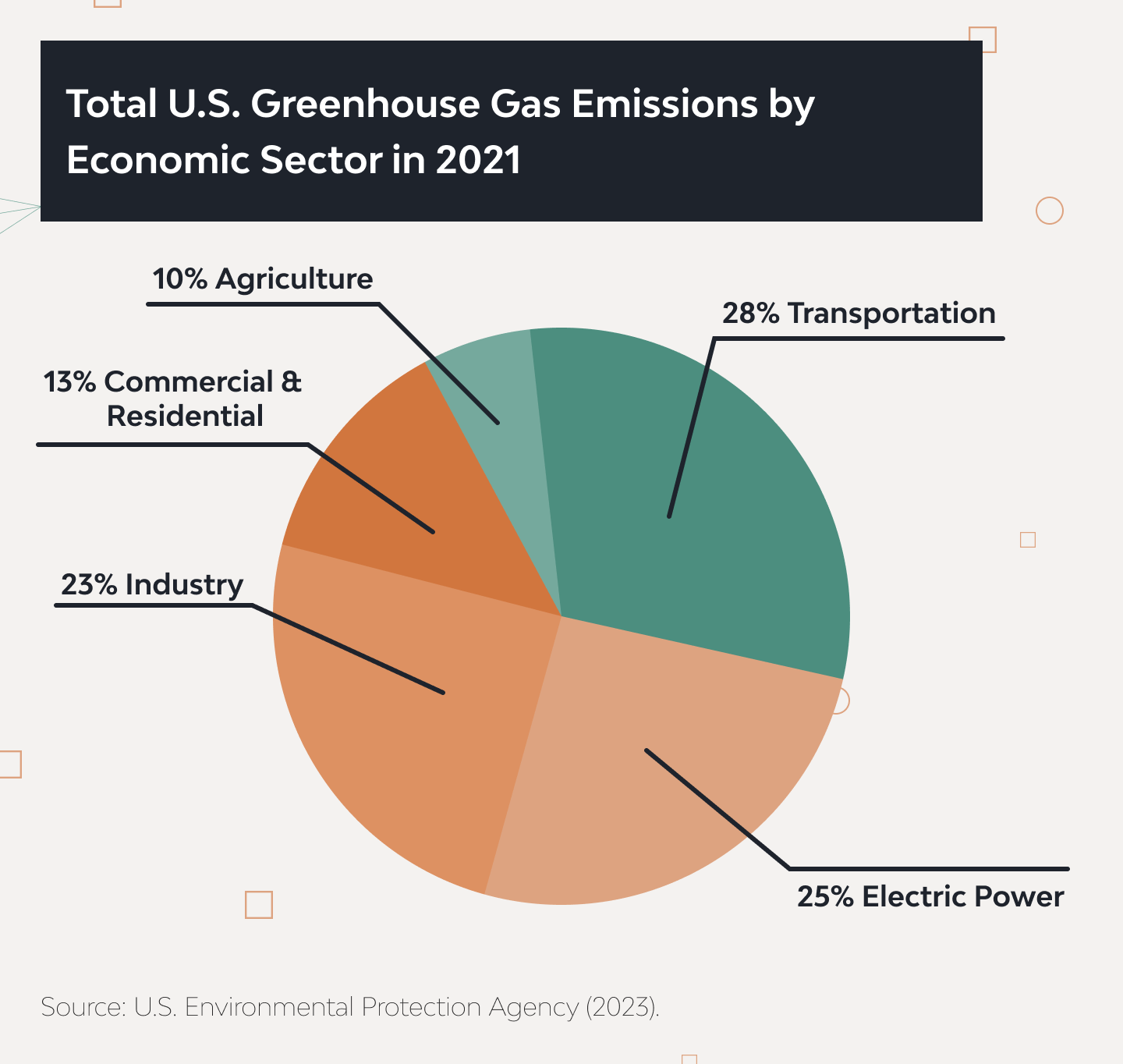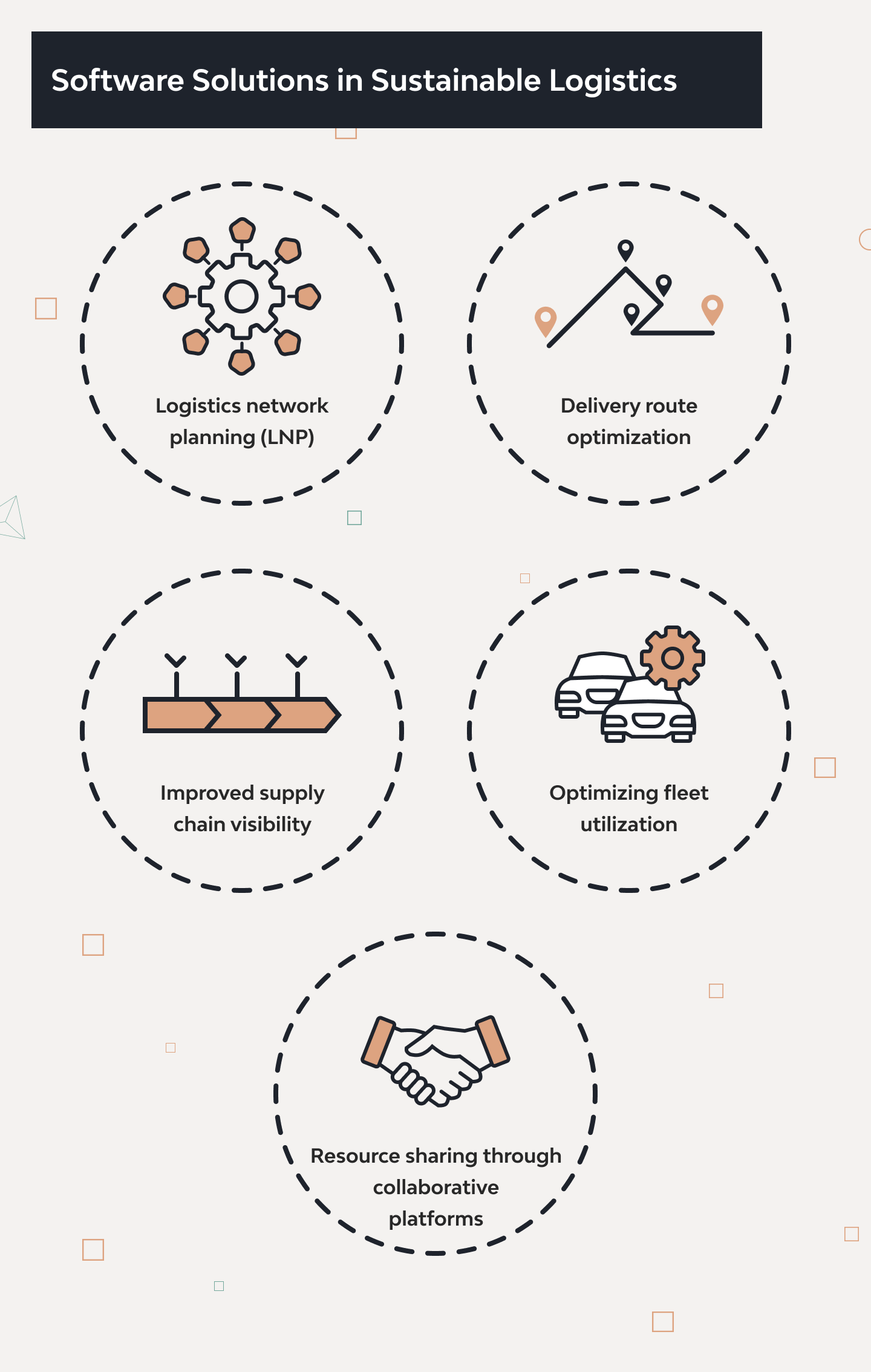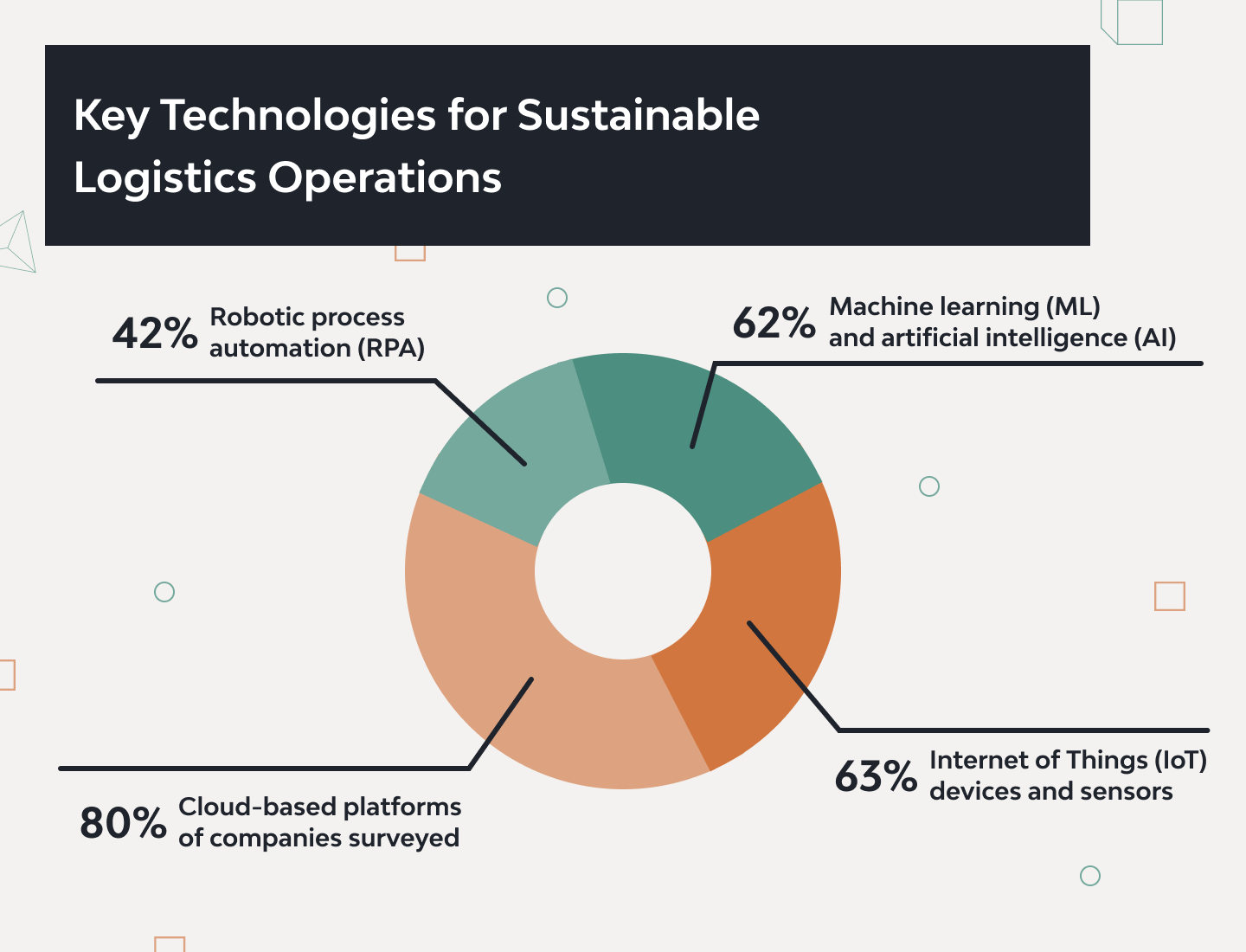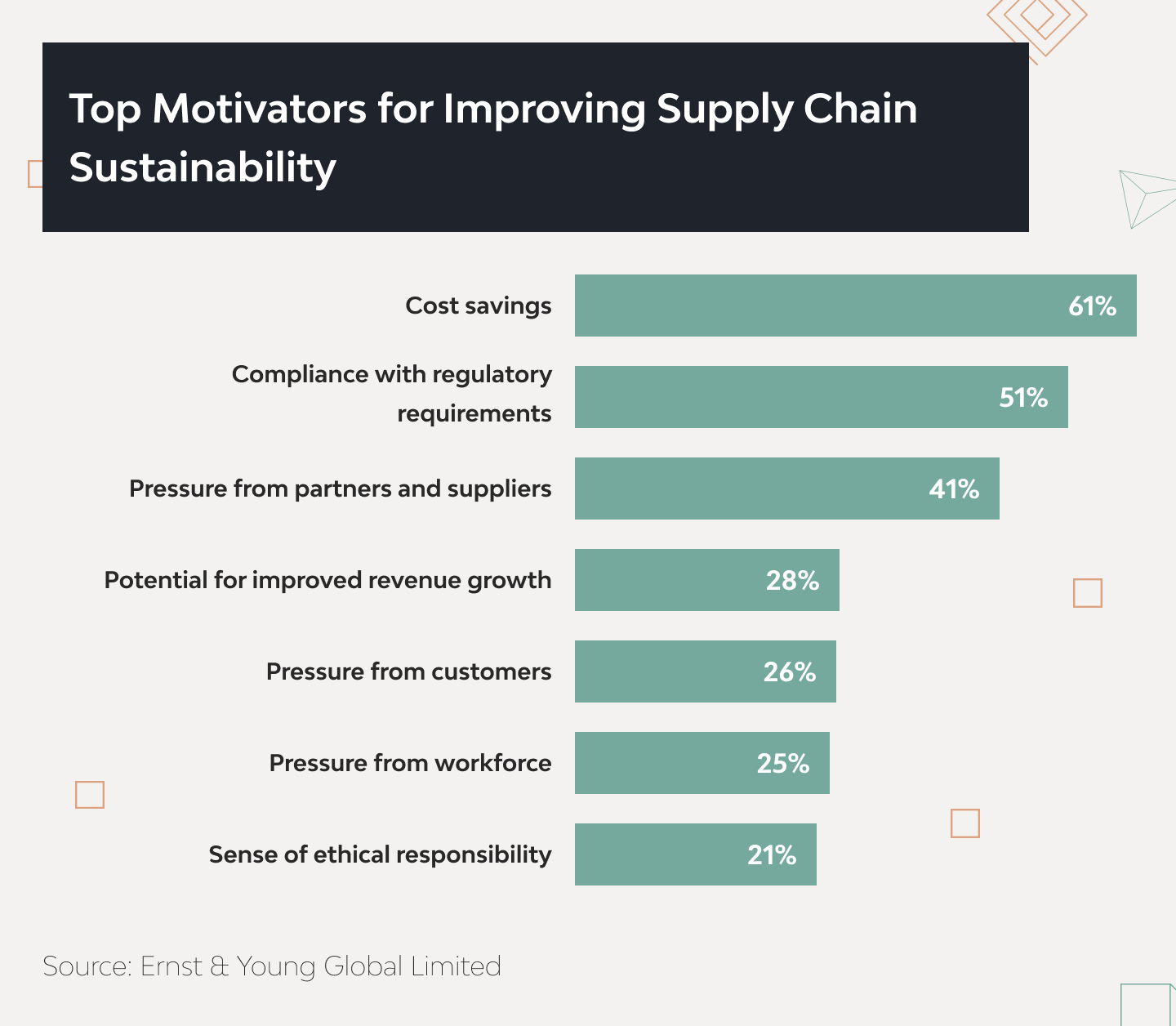Sustainability in Logistics: The Role of Software Solutions in Reducing Carbon Footprint

Rising consumer awareness and new regulations concerning greenhouse gas emissions are pushing transportation companies to achieve higher sustainability in logistics. Global names such as FedEx, Amazon, and Maersk have already set goals to minimize their carbon footprint and reach net-zero emissions by 2050 or earlier.
And it’s not just a marketing ploy. With the introduction of new initiatives and standards like ISO 14083, what was once business as usual now costs companies more, thanks to high fuel costs and CO2 pollution taxes.
At Django Stars, we’re committed to applying technology to business to create more efficient and industry-compliant solutions for our clients. Contributing to sustainable logistics practices falls perfectly within that scope — in fact, we recently helped a growing US logistics company build a collaborative resource-sharing platform. With the new solution, companies can minimize deadhead mileage and reduce their carbon footprint.
Read Also: Strategies for Sustainable Startup Growth
This article covers the features and technologies of software solutions for sustainability in logistics and supply chain management and gives real-world examples of how they’re being implemented today. But first, let’s look at the current state of emissions in the industry.
Carbon Footprint in Logistics: Statistics to Consider
The transportation and logistics industry accounts for just over a third of global CO2 emissions, making it the largest emitting sector in many advanced economies. In 2021, the industry polluted the air with 7.7 gigatonnes of CO2 — 8% more than the previous year.

These numbers reflect the growth in demand for global trade alongside traditional logistics practices that rely heavily on fossil fuels. The introduction of low-carbon and electric vehicles has thankfully slowed the rapid growth in carbon dioxide emissions, with total transport emissions increasing by just 2.1% in 2022. Yet for logistics and transportation to meet the world’s net-zero targets, the sector still needs to reduce its emissions by around 20% (to less than 6 Gt) by 2030.
In the face of ever-growing demands for transportation and capacity, companies need all the help they can get to meet their targets. While using ecologically friendly vehicles and solar power for warehouse operations are crucial steps, digital transformation is also key to achieving sustainability in logistics.
The Role of Software Solutions in Sustainable Logistics
Implementing digital solutions has the potential to reduce global emissions by up to 20% in high-emitting sectors through better management of resources. The logistics sector has a key part to play, and software helps achieve three main sustainable logistics goals:
- Calculating and tracking the carbon footprint of logistics operations
- Optimizing the use of fuel, vehicles, and space to cut pollution
- Improving supply chain visibility and resource sharing
Here’s where software solutions make a difference in more detail.

Logistics network planning (LNP)
With efficient network planning software, businesses can plan the size, location, and operations of warehouses and transportation routes more effectively. Powered by ML algorithms, this software finds patterns in historical data and outlines possible what-if scenarios. These help businesses anticipate and prepare for unexpected market disruptions.
In short, LNP solutions promote greener companies by making the best use of available resources, improving business operations, and reducing energy consumption and costs.
Delivery route optimization
The automation and AI capabilities of route optimization software help businesses plan and optimize their delivery routes based on multiple variables, including order volume, vehicle load, time windows, and traffic conditions. The software also provides real-time updates on fleet locations and delivery statuses, allowing managers to monitor and manage vehicle condition and maintenance.
Route optimization software can help minimize mileage, reduce fuel consumption, and lower emissions. As a result, companies achieve significant cost savings, improve customer satisfaction through on-time deliveries, and reduce their environmental impact.
Improved supply chain visibility
McKinsey research suggests that 45% of logistics executives have no visibility into their upstream supply chain or only know their first-tier suppliers. Technologies such as digital passports allow companies to trace the origin of the raw materials and components used in their products. This helps businesses ensure responsible sourcing practices — for example, by avoiding suppliers connected with deforestation, child labor, or human rights violations.
As a result, companies can better manage supply chain risks, meet their sustainability goals faster, and demonstrate their commitment to responsible sourcing to consumers, stakeholders, and regulatory bodies.
Optimizing fleet utilization
An optimally sized fleet can significantly decrease fuel consumption, which cuts emissions and fuel costs. Backed by GPS and IoT sensors, fleet management software can give companies real-time visibility into
- Precise fleet location, including containers and packages
- Internal container temperature, humidity, and related data
With real-time visibility into operations, companies can improve asset utilization, minimize delays, and enhance overall operational efficiency. The software can also intelligently assign drivers to routes by taking into account factors like driver availability and workload balancing. The result is optimized resource allocation and improved logistics sustainability.
Resource sharing through collaborative platforms
Deadhead mileage drags operational efficiency down. Collaborative software platforms address the problem by facilitating the sharing of resources such as warehouse space, transportation capacity, and last-mile delivery services among companies and stakeholders.
Research shows that shipment consolidation can reduce total shipping costs by 40% and decrease fuel consumption and emissions, thus promoting logistics sustainability.
Now that we’ve covered how software can facilitate sustainability in logistics and transportation, let’s dive into the key technologies logistics software needs to drive positive environmental and social impacts.
Key Technologies for Sustainable Logistics Operations
An Ernst & Young (EY) study shows that 63% of logistics companies are increasing their use of technologies for sustainability tracking and measurement. These technologies include:
- Cloud-based platforms — 80% of companies surveyed
- Internet of Things (IoT) devices and sensors — 63%
- Machine learning (ML) and artificial intelligence (AI) — 62%
- Robotic process automation (RPA) — 42%

Cloud-based platforms
Cloud-based platforms are more energy-efficient than on-premise infrastructure. Cloud solutions can help companies reduce their environmental footprint, improve resource efficiency, increase regulatory compliance, and get better visibility into inventory levels and transportation capacities.
In an Accenture survey, 48% of supply chain executives reported that moving to the cloud had helped them meet sustainability goals.
IoT monitoring
RFID tags, GPS, and other IoT sensors allow companies to track and continuously monitor different aspects of logistics operations, including vehicle and container location, temperature, and humidity. This real-time data contributes to more proactive decision-making, higher route optimization, less idle time, and reduced fuel consumption and emissions.
AI and ML capabilities
McKinsey states that adopting AI for supply chain management has helped early adopters cut logistics costs by 15%, improve inventory levels by 35%, and service levels by 65%. This comes as no surprise since AI’s ability to analyze vast volumes of data and perform patterned work increases operational visibility and helps companies follow sustainable logistics practices.
Machine learning, in turn, can analyze and learn from historical data on traffic patterns, weather conditions, and delivery time windows to optimize routes. The Future Today Institute’s 2023 report on logistics shows that using ML-powered route optimization can save 20-40% on fuel and drive time. This lowers carbon emissions and contributes to logistics sustainability.
All these technologies show the immense potential of software solutions to help reduce carbon emissions. Yet, just like any new initiative, adopting sustainability in logistics and supply chain management also presents challenges.
Overcoming Challenges and Promoting Adoption
The 2022 EY study shows that 80% of senior supply chain leaders emphasize the importance of sustainability in logistics and environmental, social, and governance (ESG) initiatives. Cost savings, regulatory compliance, and revenue growth potentials are the top motivators pushing businesses to embrace sustainable logistics practices.

While many companies have developed long-term sustainability strategies spanning several years, only a few have the necessary visibility, technology, and comprehensive programs to measure their progress effectively.
As a result, nearly half of logistics leaders reported that their companies struggle to measure ROI on adopting sustainability for logistics activities. Without the appropriate technology to collect and analyze data from multiple sources, performance metrics often remain less advanced and rely on qualitative rather than quantitative data.
The good news is that effective change management strategies and a reliable logistics software development partner can help businesses overcome resistance and create a culture that embraces sustainability in logistics.
Case Studies and Success Stories
Despite the challenges, many companies have succeeded in meeting their combined sustainability and logistics goals by adopting advanced technologies and digitizing supply chain operations. Here are some real-life examples.
Route optimization to reduce carbon footprint
Global logistics company UPS has adopted several innovative technologies and strategies to reduce its carbon footprint and enhance its environmental performance. The company’s proprietary routing software, ORION, incorporates ML algorithms to optimize delivery routes. As a result, UPS saves millions of gallons of fuel and reduces carbon emissions by eliminating unnecessary transportation miles.
DHL’s 2022 Sustainability Highlights cite a 6.9% reduction in CO2 emissions worldwide. Furthermore, they have set a target to achieve a 40% reduction in greenhouse gas emissions intensity by 2025, compared to 2007.
Sustainable logistics software
Global logistics and transportation company DB Schenker has also embraced sustainable logistics software and practices as a means of reducing their environmental impact.
The company’s in-house BinPACKER software optimizes container load planning, leading to improved space utilization and lower transportation costs and emissions.
Cutting CO2 emissions through collaboration
One of the solutions developed by Django Stars is also helping a US transportation company reduce its carbon footprint. Our team implemented delivery route optimization and real-time visibility and tracking for the company’s shared resource platform. The platform optimizes resource usage, encourages other businesses to use more sustainable solutions, brings extra income to the client company, and ultimately promotes sustainability in logistics.
Conclusion
Meeting the new standards, targets, and expectations for logistics sustainability is key to staying competitive as action against climate change ramps up. While shifting to electric vehicles and solar power are key steps, digitizing supply chain operations can also help companies improve logistics sustainability.
Software improves operational transparency and efficiency and reduces costs through better resource management. Intelligent platforms help companies identify areas where improvement is possible and measure progress toward sustainability goals.
Django Stars can help your company embark on its sustainability journey. Contact us to discuss how we can build your sustainable logistics practices through technology.
- Why is it essential to reduce carbon footprint in logistics?
- Reducing carbon footprint in logistics is key to mitigating climate change, minimizing environmental impact, and promoting sustainable logistics practices.
- How large is the carbon footprint of the logistics industry?
- The logistics and transportation industry accounted for over a third of global CO2 emissions in 2021. The growth in demand for international trade and traditional logistics practices contribute to pollution growth.
- How can businesses promote the adoption of sustainable logistics solutions?
- Setting clear sustainability goals, investing in green technologies, and digitizing supply chain operations can all help logistics businesses measure their environmental impact and work towards reducing their carbon footprint.
- What role do software solutions play in reducing carbon footprint?
- Software solutions give companies real-time visibility into their operations, help optimize routes and resource usage, and enable analytics-driven decisions. These, in turn, lead to reduced carbon emissions and improved environmental sustainability.








